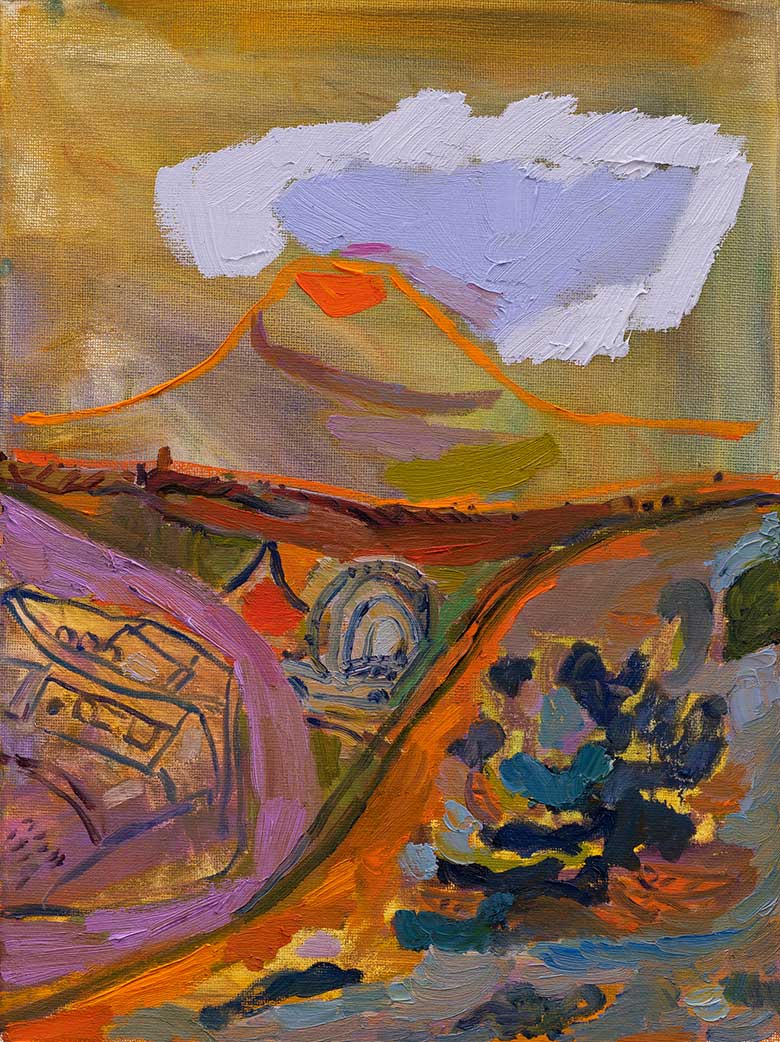The destruction wreaked by the events of the year can be understood in terms similar to the Vesuvius explosion, and Sanditz states that a metaphorical volcano has ‘erupted since [she] started these paintings’. With no prior knowledge of the events to come, Sanditz produced an omniscient body of work, one that encapsulates the anarchic geopolitical eruption of 2020.
Lisa Sanditz uses her artistic practice to engage with the world politically. Using bold colour, dense texture, and a wry sense of humour as her weapons against the world’s injustices, she recently focussed her attention on the turbulent political landscape of the USA. Sanditz readily grapples with social inequality, often blending memory and anecdotal narratives within her paintings. Her wider practice draws on ecology, human consumption, and urban/rural environments, questioning how we commercialise and commodify the very environment that sustains us.
While spending 6 weeks in total lockdown, Sanditz created a body of work responding to COVID-19’s ruinous effect on the US. She also revisited older works, and began to view a particular group of works created pre-pandemic under a new light. Produced in January 2020, just weeks before COVID-19 reached Europe and the United States, her studies of Mount Vesuvius appear to prophesize the nature of the following year’s events with an eerie accuracy.
Each canvas measures a small 16 x 12 inches, a recognisably tight space to explore the effects of a natural disaster. These works reference the eruption of Mount Vesuvius in AD 79, which destroyed the Roman cities of Pompeii and Herculaneum, among others. 1000 people are thought to have died in the blast, with the volcano still regarded as one of the most dangerous in the world today. Mt Vesuvius Study I depicts the volcano mid-eruption, suggested through a distinctive orange line and lilac interpretation of molten rock seeping into the air. Below, the town remains unaffected, leaving the viewer to consider the inevitable destruction yet to occur. Mt Vesuvius Study II introduces the disaster from a new angle, encompassing a wider view of the eruption. Vesuvius appears as a minuscule dark form, emitting ash and gas in heavily textured bands of green and brown that appear to continue far beyond the limits of the frame. As the deadly clouds billow, we are once again offered a glimpse of the pastoral town awaiting imminent devastation. Both canvases share the same layers of thickly applied paint, visible in Sanditz’s brushwork which is sometimes measured, and often frantic. As such, Sanditz captures the deadly realities of Vesuvius’ historic eruption, confining the monumental event in two portrait canvases.

Mt Vesuvius Study II, 2020
After much contemplation during the isolated months following January 2020, Sanditz began to regard these small canvases as metaphors for broader ideas and truths. 2020 in the US was defined by Trump’s presidency, the pandemic, environmental devastation of the West Coast wildfires, and the fight for racial justice with civil rights movements protesting across the country. In many ways, these occurrences can be understood as a geopolitical eruption. The destruction wreaked by the events of the year can be understood in terms similar to the Vesuvius explosion, and Sanditz states that a metaphorical volcano has ‘erupted since [she] started these paintings’. With no prior knowledge of the events to come, Sanditz produced an omniscient body of work, one that encapsulates the anarchic geopolitical eruption of 2020
(By Eleanor Lerman)
